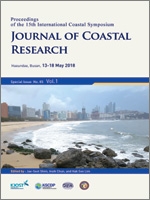Lee, S.-O.; Kim, W.-J., and Cho, Y.-S., 2018. Generation of a New Tsunami Hazard Map for the Port of Imwon. In: Shim, J.-S.; Chun, I., and Lim, H.S. (eds.), Proceedings from the International Coastal Symposium (ICS) 2018 (Busan, Republic of Korea). Journal of Coastal Research, Special Issue No. 85, pp. 726–730. Coconut Creek (Florida), ISSN 0749-0208.
Tsunamis, which are long-period oceanic waves mainly generated by undersea earthquakes, can be one of the most devastating types of natural hazard. Tsunamis frequently occur around the rim of the Pacific Ocean, including the East Sea. The most plausible and frequently chosen tsunami hazard mitigation measure is to generate a tsunami hazard map based on probable maximum tsunamis. Probable maximum tsunamis in the present study are three historical tsunamis and 11 virtual tsunamis. The port of Imwon, located on the eastern coast of the Korean Peninsula, is vulnerable to an unexpected tsunami strike. The Central East Sea Tsunami that struck in May 1983 resulted in three human casualties (one death and two people missing and presumed dead) and property damage. The present study generates a tsunami hazard map for the port of Imwon. Shelters and evacuation routes are determined according to selection criteria and a field survey. The newly developed tsunami hazard map can be used by local authorities in the case of a real tsunami.





